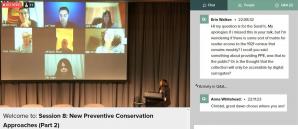Session 8
Submitted by sharragrow on 09 Sep 2022

Thursday, Session 8: New Preventive Conservation Approaches (2)
Reviewed by Júlia Junger
“New Preventive Conservation Approaches (2)” was the eighth session of the IIC Congress, being one of the last presentations in the hybrid format. It focused on the new perspectives and attitudes regarding preventive conservation, with papers that varied from local studies to new notions when dealing with more contemporary art, while not ignoring sustainability, which has been a popular topic in the conservation field now more than ever. In terms of content, three of the papers were quite similar in what they proposed, and tests were conducted locally, though the chosen materials were varied.
In Mould Matters: Implementing a New Workflow for Managing Mould-affected Archival Documents and its Impact on Resources and Wellbeing, Sarah Noble, Sarah Vansnick, and Carina Rosas focused on the re-evaluation of the mould cleaning methods in The National Archives’ (UK) collection, carrying out a pilot project in order to optimize these processes. Christel Pesme and Kirsten Dunne talked about the assessment changes and the definition of a priority scale based on value when referring to light risk mitigation at the National Galleries of Scotland, performing the pertinent tests at the Artist Rooms touring collection in The Continuing Development of Display Recommendations at the National Galleries of Scotland: Exploring a Value-based Decision Strategy for Light Risk Mitigation; and in Better Use of Showcases for Preservation and Sustainability. David Thickett presented extensive research on showcase environmental conditions and predictions relating the materials’ sensitivity and ideal settings for sustainability in the foreseeable future. Joel Taylor and Hélia Marçal, in Conservation in the Performative Turn, emphasised how conservation practices and concepts are undergoing changes and how the handling of cultural heritage should adapt.
The follow-up Q&A hybrid session was remarkable, with some discussions even having to be left to later due to time restrictions! This proves that the Congress is really making a change and acting as an ideal medium between colleagues from all over the world, which is essential in the comparative sense. It is important to note that the panellists often complemented each other’s discourses, enriching the discussions further, as new perspectives were added. This level of active engagement was due to the practicality of the implementations as presented by the speakers. Of special note, the discussion also included the possibility of adaptation; for instance, an attendee asked the UK-based authors how their studies could be performed in Singapore, which has a completely different climate.
Personally, the paper that stood out the most was Conservation in the Performative Turn due to its subject topic. Contemporary art discussions are relatively recent, where there are more questions than answers, making the case study fitting, evidencing the ethics and technical issues that face the field. Moreover, the usage of different and industrial materials is something that cultures from all around the world share, so it was easy to understand. In conjunction with this, inquiries about the definitions, relevance and history of cultural heritage are being taken more seriously as people face their own history in a less extenuated way. Having said that, I posed a question for the authors during the session, which was about
the possible changes that documentation practices would have to go through to keep up with these new understandings, for the whole process to be congruent. They replied that this would most likely occur, while adding that new technologies and interdisciplinary work would be helpful. Hélia summarized the process well when she said that in this case, documentation would be “more than a conservation method”.
This session reminded us that commonly known concepts and practices are subject to change due to time and due to the fact that it would be damaging to keep them static, especially after the huge turnaround the art world experienced with the arrival of Modern art. Changes in the configurations of collections, as well as their natures, imply that the professionals in this field should keep pace with new methodologies. It is clear that we should always promote discussions with fellow conservators, spreading new findings and research results so that they can be compared and applied in other places, allowing us to provide the most suitable care for our respective cultural heritage, which is the goal.

Author
Júlia Junger is a conservation and restoration student at the Federal University of Rio de Janeiro, Brazil.
Image caption
Image: Screen shot of the panellists during the Q&A Session (Zoom meeting), as well as the chat with a question from Erin Walker. Image taken by Júlia Junger, from Session 8.